

'Iron Man' Exoskeletons Go Soft. Forget Iron Man armor and exoskeletons.
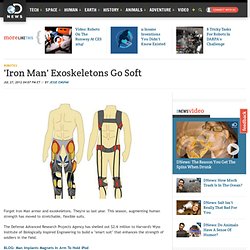
They're so last year. This season, augmenting human strength has moved to stretchable, flexible suits. The Defense Advanced Research Projects Agency has shelled out $2.6 million to Harvard's Wyss Institute of Biologically Inspired Engineering to build a "smart suit" that enhances the strength of soldiers in the field. BLOG: Man Implants Magnets In Arm To Hold iPod. News - Is It Future Yet? : Videos. 3D printing allows for customizable prosthetic limbs. We know that 3D printers can achieve many things, and prosthetic limbs is one of them.

However instead of offering up a normal, and plain looking prosthetic limb, a San Francisco-based company called Bespoke Innovations is using 3D printing and modeling technology that will provide prosthetic limbs featuring custom designs. The process is rather simple – the company will scan both the client’s natural and prosthetic leg and once the model has been created and adjusted accordingly, the customers can then begin to choose his/her designs that appear on the limb. Stiletto heel implants concept. Body modifications have been the norm for some years already, and some of them might still take some getting used to such as tongue splitting, but here is a concept that will definitely throw you off balance – I’m referring to having stiletto heel implants. Goodness knows how you’re ever going to complete a decent round of jogging once you have these implants inside of you!
I would suppose if there is a high enough demand to see this implant actually become reality, it would exist – but thankfully, nothing of the sort has happened yet. Synthetic vocal cords could be the future. There are some things in life, just like Humpty Dumpty, that once broken, can no longer be put back together again.

The same can be said for one’s ear drums and vocal cords. Singers such as Julie Andrews (of Sound of Music fame), whose legendary voice experienced permanent damaged in an operation which happened half a decade ago, might just benefit in the future after the synthetic vocal cord is perfected. The video that you see above was filmed in the lab of 2012 ACS Priestley Medalist and MIT Institute Professor Robert Langer, and since a picture speaks a thousand words, it makes sense for this video to explain just how artificial polymer vocal cords could be the solution in repairing damaged vocal tissue.
Dream of making artificial body parts becoming a reality. It sounds like a sci-fi movie – doctors growing body parts to cure our ills.
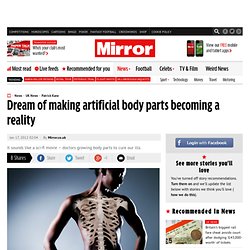
But thanks to incredible breakthroughs, bionic repairs for humans are fast becoming a reality. Experts yesterday revealed they are perfecting “off the shelf” blood vessels, which could revolutionise treatment of heart attacks and strokes. If the Cambridge University blood vessel team is successful, patients could be spared major operations. The test tube vessels may also treat kidney dialysis patients and repair injuries. And because the patient’s own skin cells are used, there is less chance of rejection. Wearable robot puts paralysed legs through their paces. This article was taken from the February 2012 issue of Wired magazine.
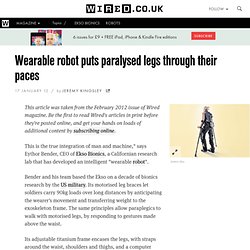
Be the first to read Wired's articles in print before they're posted online, and get your hands on loads of additional content by subscribing online. This is the true integration of man and machine," says Eythor Bender, CEO of Ekso Bionics, a Californian research lab that has developed an intelligent "wearable robot". Chip-based human organs are part of the future? Do you think that humans have gotten too smart for their own good?
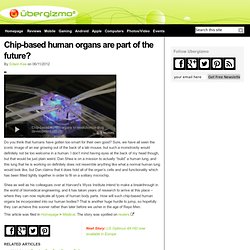
Sure, we have all seen the iconic image of an ear growing out of the back of a lab mouse, but such a monstrosity would definitely not be too welcome in a human. I don’t mind having eyes at the back of my head though, but that would be just plain weird. Chemical circuits for the body? The human body can be considered to be a miracle by itself – just take any cell, and break it down to the minutest detail, and you would see the wonder of it all.
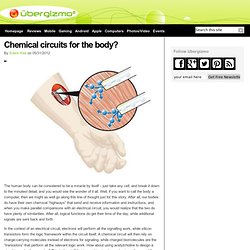
Well, if you want to call the body a computer, then we might as well go along this line of thought just for this story. After all, our bodies do have their own chemical “highways” that send and receive information and instructions, and when you make parallel comparisons with an electrical circuit, you would realize that the two do have plenty of similarities. After all, logical functions do get their time of the day, while additional signals are sent back and forth.
In the context of an electrical circuit, electrons will perform all the signalling work, while silicon transistors form the logic framework within the circuit itself. Grow your own body parts. When I watched the movie “Repo Men”, it certainly made me wonder just how far doctors of tomorrow have “advanced” from today, and the Hippocratic Oath does not seem to matter any more.
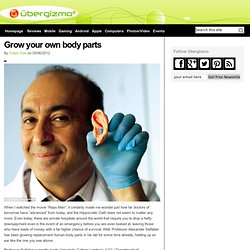
Even today, there are private hospitals around the world that require you to drop a hefty downpayment even in the event of an emergency before you are even looked at, leaving those who have loads of money with a far higher chance of survival. Well, Professor Alexander Seifalian has been growing replacement human body parts in his lab for some time already, holding up an ear like the one you see above. Professor Seifalian currently leads University College London’s (UCL) Department of Nanotechnology and Regenerative Medicine, which he has fondly (and jokingly) dubbed the “human body parts store”. Seifalian and his team are working on growing replacement organs and body parts made to order through the clever manipulation of a patient’s own cells.